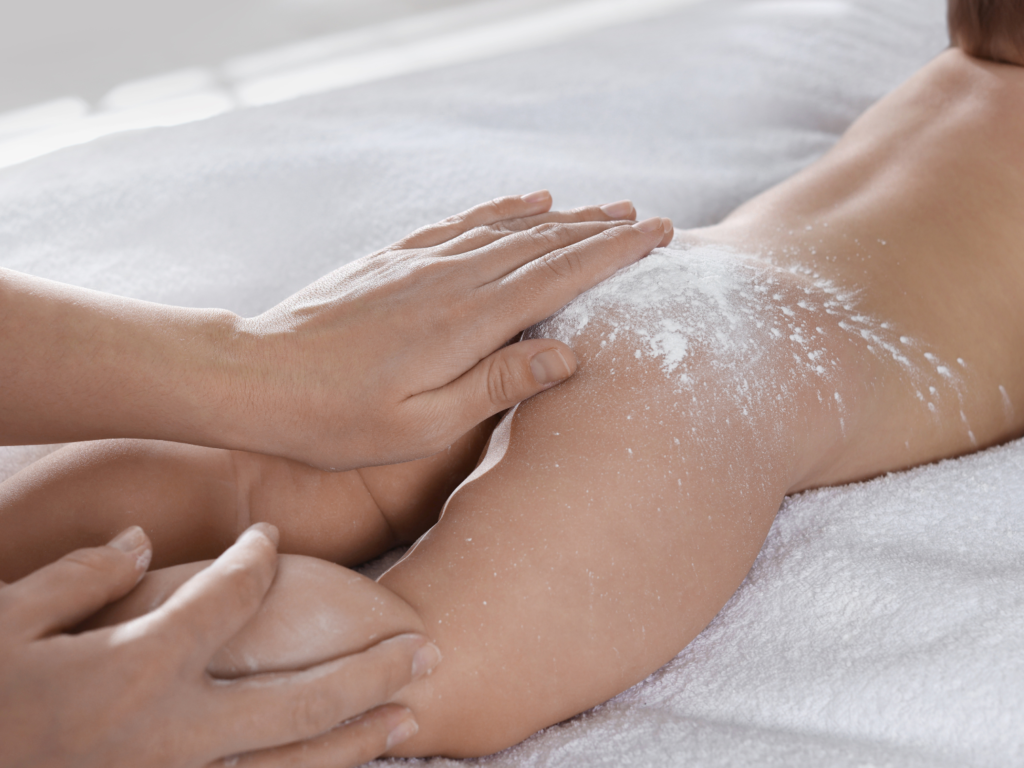Baby powder has been a nursery staple for generations. The fine, white talcum powder is used to help absorb moisture and reduce friction on a baby’s delicate skin. Many parents use it routinely after bath time and diaper changes to help prevent rashes. However, recent concerns about asbestos contamination and links to cancer have raised alarms about the safety of this product. Should you be using baby powder on your little one? Let’s take an in-depth look at the potential risks.
When I first became a mom, baby powder was one of the items I dutifully stocked in preparation for my newborn’s arrival. Like most parents, I wanted to use gentle, soothing products on my baby’s skin. The sweet-smelling powder seemed harmless enough. As a first-time parent, I simply followed the advice of generations before me without question. But over the years, I’ve come to re-evaluate many of my choices as new evidence on safety comes to light. The fresh baby scent may invoke happy memories, but is tradition worth the potential risks?
The concern around baby powder centers on its main ingredient, talc. Talc is a mineral made up of magnesium, silicon, and oxygen that is mined from rock deposits around the world. In its natural form, talc mineral deposits often contain asbestos, a known carcinogen. Asbestos can make its way into the finished powder products. There is also some evidence that talc itself may promote cancer development in the ovaries and lungs. This raises troubling questions for parents who want to make the safest choices for their infants.
Is There Asbestos in Baby Powder?
For many years, it was an open secret in the manufacturing world that talcum powder products frequently tested positive for asbestos. Asbestos fibers are often naturally interwoven with talc deposits in the earth. This means that asbestos can easily end up in talc that is mined and used in consumer goods unless careful filtering and processing is done.
Some of the big-name baby powder brands produced talc-based powders that contained asbestos into the 1970s and 80s. For example, Johnson & Johnson did not eliminate asbestos from its baby powder until the late 1970s. Recently, the company has come under fire because asbestos was detected in some bottles of baby powder as late as the early 2000s. This has raised concerns that contamination may still be an issue.
Other brands have also reformulated over the years after finding asbestos in their talc supply and finished powders. In 1976, a sample of Cashmere Bouquet powder was found to contain up to 15% asbestos. In the 1980s, Chanel pulled a talc-based powder from the shelves after regulators turned up asbestos contamination.
While many major brands now source their talc from known asbestos-free mines and perform routine testing, 100% purity is difficult to guarantee. Some note that current testing methods may not be sensitive enough to detect microscopic asbestos fibers. Short of an outright ban on talc powders, there may always be questions about possible low-level contamination we simply cannot detect.

How Much Asbestos Is Safe?
When it comes to a substance like asbestos that is a known hazard, many advocates argue that the only acceptable level is zero. There is no established “safe” threshold of asbestos exposure. While stricter regulations have pushed levels down in recent decades, even tiny amounts carry a cancer risk.
The Occupational Health and Safety Administration (OSHA) set a rather permissive limit of 0.1 asbestos fibers per cubic centimeter of air in the workplace. Consumer safety advocates argue this does not go far enough to protect public health. Groups like the Environmental Working Group urge a complete ban on talc products that can potentially be tainted with carcinogenic asbestos dust.
For companies, completely removing asbestos from talc deposits is challenging. Talc and asbestos minerals form together in nature. No extraction method can guarantee zero contamination. That’s why some manufacturers have reformulated their products to use substitutes like cornstarch instead of talc. This eliminates the possibility of asbestos exposure.
Link Between Talc Powder and Cancer
Even if asbestos contamination could be completely controlled, there are still concerns about talc itself.
The use of talcum powder in the genital area by women has been most closely tied to higher cancer rates. Numerous studies over the past few decades have found a statistical link between talc application on the perineum and ovarian cancer. A 2018 analysis looked at data on over 250,000 women. It concluded that regular talc use raised ovarian cancer risk by 30-60%.
The powder industry argues that this evidence is merely circumstantial. But it does make biological sense. Talc particles used vaginally can migrate up to the ovaries and cause chronic inflammation. This irritation over many years may set the stage for cancer growth. Researchers continue to study the association to prove causation beyond correlation.
The evidence is less clear about cancers like lung cancer or mesothelioma. Because asbestos is known to cause these cancers, contamination may play a role. However, studies on talc alone have not found the same strength of association.
There are some hypotheses about how talc may lead to cancer formation. Some evidence suggests talc causes oxidative stress and damages cells’ DNA. Others theorize that mineral particles can trigger chronic inflammation, which promotes tumor growth. The exact mechanisms are still being investigated.
Thousands of lawsuits alleging talcum powder caused cancer have been filed against Johnson & Johnson in recent years. In some cases, plaintiffs have produced records showing the company was aware of small amounts of asbestos in its powders but failed to inform consumers or regulators. So far, juries have delivered mixed verdicts. While not definitive, the lawsuits signal an urgent need for more safety research.
What Types of Cancer Is Talc Implicated In?
The cancer most strongly associated with talc powder seems to be ovarian cancer in women. In 2018, a prominent study concluded genital talc use increased ovarian cancer risk by 30-60% in women, though it did not find a similar link to asbestos. The data is most convincing for this type of women’s cancer.
Limited evidence points to slightly higher rates of other cancers like lung, laryngeal, uterine, and rectal cancer with talc exposure. However, the relative risk increase appears to be much smaller than for ovarian cancer.
When talc has been contaminated with asbestos in the past, the biggest concern would be mesothelioma. This deadly cancer affects the lining of the lungs and abdomen. While pure talc shows an association with several cancer types, asbestos specifically raises the risk of mesothelioma when inhaled. Even trace exposures can be very hazardous.
Overall, experts urge particular caution with using talc products in the female genital area due to the strength of the ovarian cancer data. More research is still needed to clarify the exact risks for other types of cancer.

Alternatives to Talcum Powder
With concerns about the safety of talc-based powder, many parents want to know what the options are. There are some non-talc powders on the market made from other natural starches. These include:
- Cornstarch – Probably the most common talc alternative found in baby powders today. Look for pure cornstarch without added fragrances or oils.
- Arrowroot – Derived from a tropical plant, it absorbs moisture well. Ensure it’s not combined with talc.
- Tapioca – Tapioca starch from the cassava plant is another option if you want to avoid talc.
- Rice starch – Also naturally absorbent and soft on the skin. Check for additives.
The main advantage of these plant-based alternatives is that they do not carry any risk of asbestos contamination like talc might. Cornstarch, arrowroot, and tapioca are processed from food crops grown in controlled agricultural environments that are asbestos-free.
However, some caution that plant starches may increase the growth of yeast and bacteria. This could aggravate diaper rash for babies prone to yeast. As always, test alternatives on a small patch of skin first to rule out unlikely allergic reactions.
When evaluating powder options, I prefer to avoid unnecessary additives like synthetic perfumes. But overall, the plant-based powders seem to be safer than talc when it comes to worries about asbestos or ovarian cancer links. Still, moderation is wise with any powder near a baby’s lungs or reproductive organs.
Tips for Safe Use of Baby Powder
If you choose to use a talc-based baby powder, there are some basic precautions to follow:
- Stick to trusted brand names without prior asbestos contamination if possible. Johnson & Johnson faced class action lawsuits for failure to warn about asbestos risk. Smaller brands may be less reliable. Check companies’ reputations.
- Avoid inhalation of powders, which can send mineral particles deep into the lungs. Apply lightly and keep away from the baby’s face.
- Store containers sealed and undisturbed to prevent cross-contamination of asbestos from other sources. Inhaling airborne asbestos, even occasionally, is a hazard.
- Minimize use on girls’ diaper areas to lower any theoretical risk to reproductive organs. Focus on just enough to stay dry.
Above all, consult your pediatrician about whether to use baby powder at all. There are often other effective options to deal with diaper rash, like frequent changes, barrier creams, oil treatments, and keeping the area exposed to air. While powders seem like a nursery necessity, they may not be mandatory with the right skin care regimen. It’s worth questioning old assumptions to make the healthiest and safest choices as parents.
Conclusion
Like many parents, I grew up assuming talcum powder was a harmless nursery necessity. Now, extensive research showing contamination with carcinogenic asbestos gives me pause. Evidence linking talc itself to ovarian cancer also raises red flags, especially for regular feminine hygiene use.
While major brands have lowered asbestos levels in recent decades, minute fibers likely persist in some talc deposits. We have also discovered talc itself may encourage certain cancers if powder particles travel to internal tissues. For lung health and female cancers, these are worrying findings.
Rather than take a gamble, I choose alternative powders made from safe food starches instead of talc. Options like pure cornstarch seem to avoid the risks of asbestos exposure and reproductive harm that may come with talc. Still, moderation is wise as too much powder could aggravate skin irritation or be inhaled.
Ultimately, all parents must weigh the evidence available today and make their own informed choices. If sticking with talc, select reputable brands and implement precautions to minimize health risks. But for many families, the peace of mind of safer alternatives like corn starch outweighs brand loyalty to talc-based powders. Our babies’ well-being is too precious. Always seek medical advice about your specific situation. However, consumer safety should be the priority when health concerns arise.
FAQs
Is Johnson’s baby powder safe now?
A: Johnson & Johnson maintains its talc is purified and asbestos-free, but some questions persist. Small amounts of asbestos were found in samples as recently as the early 2000s. While procedures have improved, occasional contamination can never be ruled out entirely. Many health advocates recommend cornstarch or arrowroot powders instead to avoid uncertainty.
Are all talc powders dangerous?
A: Not necessarily, but it depends on asbestos contamination levels and other health factors. Talc consecutively tested to be asbestos-free is less of an immediate hazard, but long-term reproductive risks may still exist. Those with a family cancer history may wish to avoid talc altogether as a precaution.
What brands of baby powder have been asbestos-free?
A: Most major brands such as Johnson & Johnson, Gold Bond, and Vaseline reformulated their talc-based powders in the late 1970s to remove carcinogenic asbestos. Still, occasional contamination has occurred, so plant-based powders may be safer. Evaluate each company’s testing and purity standards.
Can you get cancer from touching baby powder?
A: Merely touching talc is unlikely to cause cancer on its own. But there are concerns if the powder is inhaled, applied routinely in feminine hygiene, or used on babies whose hands enter their mouths. Talc particles may then travel to the ovaries or lungs and cause inflammation. Always minimize inhalation and skin contact as a precaution.

